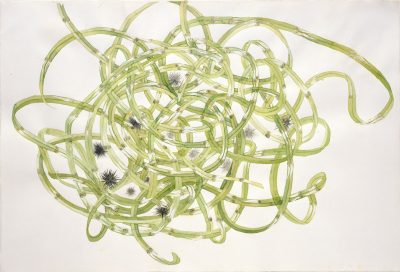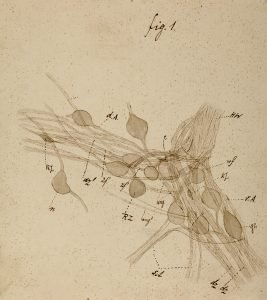Ichthyosaurus was a reptile that lived in the oceans some 200 million years ago.

Ichthyosaurus, 2005, Ellen Gallagher
To Ellen Gallagher, the term evokes an arcane scientific code, a distant, deeply embedded memory and her new body of work is inspired by the young Freud’s early passion for Darwin.
While in his early twenties, Freud did his own research on sea creatures at the marine zoology laboratory in Trieste. Writing to his friend Edward Silberstien in 1875, Freud contemplates his future career, perhaps as an oceanographer:
“…had I been asked last year what was my dearest wish, I would have replied: a laboratory and free tome, or a ship on the ocean with all the instruments a scientist needs…”
‘Ichthyosaura’ was also a code used by the young Freud when writing to Silberstein, to describe a girl (Gisela Fluss) that he had a secret crush on. Freud’s early passion for marine biology is suggested by the so-called ‘Hollthurn’ dream published in The Interpretation of Dreams (1900). He describes a recollection of a dream about finding a starfish washed up on the beach at Blackpool, England in 1875:
“When I was nineteen years old I visited England for the first time and spent a whole day on the shore of the Irish Sea. I naturally revelled in the opportunity of collecting the marine animals left behind by the tide and I was occupied with a starfish – the words ‘Hollthurn’ – and ‘holothurians (sea slugs)’ occurred to me at the beginning of the dream – when a charming little girl came up to me and said: “Is it a starfish? Is it alive?” “yes” I replied, “he is alive”, and at once embarrassed at my mistake, repeated the sentence correctly.”
Ellen Gallagher finds an affinity with Freud’s early fascination for oceanography and his surprisingly accomplished drawing skills. As a student Gallagher spent a semester aboard an oceanographic research vessel. There she began researching the migratory patterns of pteropods, collecting and documenting the specimens under a microscope. “My project was studying pteropods – wing footed snails. I chose this subject after a scientist from the Woods Hole Oceanographic Institute gave me a side talk about pteropods and it appeared to me that they looked just like butterflies, it somehow never occurred to me that they were microscopic. In reality it meant that I was on a sailboat catching these tiny things every three hours during the night and then studying them under a microscope and drawing them.”

Since 2001, Gallagher has been making a series of drawings entitled ‘Watery Ecstatic’. Carving directly into the think pulpy watercolour stock, Gallagher creates a floating world, which she relates to the mythical Drexciya, an undersea world made up of those who were lost by suicide, murder, or slow death, along the perilous Middle Passage. For Gallagher, the Middle Passage is resonant as an origin myth – where language and imagery and music were reconfigured and recombined to create a mutable constant.
Known for her experimental use of materials these drawings employ watercolour, inks, pencil and even cutting directly into the surface of the paper, and feature an undersea world populated by dream-like creatures that seem to have evolved from the depths of Drexciya. Her carved, scratched, and splattered constructions depict fantastical sea-creatures, crustaceans, exotic seaweed and the trailing tentacles of weird jellyfish. Recalling the transformation Ariel sings about in The Tempest, the drowned slide into another dimension, suffering “a sea-change, into something rich and strange”.

Freud’s ‘petromyzon’ drawings, 1878
Gallagher’s two projections, made in collaboration with Edgar Cleijne, sited within the highly charged space of Freud’s study and library, created a parallel fiction that resonates with Freud’s early oceanographic research. The films reflected collecting and categorisation as both an illuminating and constricting methodology practised during this important period of enlightenment, a methodology that often resulted in a kind of captivity for both the subject and the observer. Gallagher has also placed specimen jars within Freud’s collection, containing strange creatures from this fictional underwater world. Floating, suspended by their own weight, these creatures relate to Freud’s research into the nervous systems of the lamprey (Petromyzon) for which he created an exquisite series of drawings that have been specially displayed here for the first time.
Probing Freud’s fascination for Egypt, Gallagher has reworked the Abu Simbel photogravure, which usually hangs in Freud’s library. Adding elements of collaged from vintage ‘race magazines’, as well as Sun Ra’s incredible film ‘Space is the Place’, Gallagher builds “a trickled out, multi directional flow from Freud to ancient Egypt to Sun Ra to George Clinton.”
For this exhibition, Ellen Gallagher connected her own chartings of Drexciya, with Freud’s often-overlooked interest in oceanography. In the 1870s, Freud produced a number of rarely seen drawings of the sexual organs of marine animals, and this fascination with biology later extended to neurology as Freud developed an interest in the relationship between the spinal cord and the nervous system. Gallagher has singled out these remarkable early drawings by Freud both as an inspiration and a reference point for her own oceanic studies.